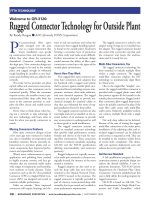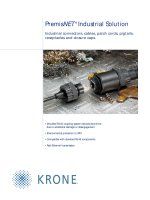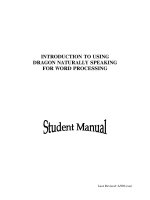Tài liệu Article - FTTH - Rugged Connectors for Outside plant doc
Bạn đang xem bản rút gọn của tài liệu. Xem và tải ngay bản đầy đủ của tài liệu tại đây (210.66 KB, 2 trang )
FTTH TECHNOLOGY
36
| BROADBAND PROPERTIES | www.broadbandproperties.com | SEPTEMBER 2005
P
re-connectorized fiber optic
cable emerged over the past
year as a major innovation that
lowers installation cost, speeds
up construction time, and improves reli-
ability. But what about the connectors
themselves? Connector technology has
also kept pace. New connector designs are
rugged enough to be used in the outside
plant, and rugged enough to withstand
rough handling by installers as new busi-
nesses and dwelling units are added to the
network.
e result: Service providers can place
optical cables and connectors near poten-
tial subscribers so that consumers can be
connected quickly. When the consumer
requests service, the installer routes a pre-
connectorized fiber drop cable from the
street to the customer premises to com-
plete the fiber circuit and enable service
activation.
Here’s what to think about when lay-
ing out a network to take advantage of
the new technology, and here’s what to
look for when you specify connectors to
match.
Moving Connectors Outdoors
Fiber optic connector designs of just
a few years ago were restricted to indoor
use, due to instability at temperature and
humidity extremes. Recent materials en-
hancements in precision plastic and ce-
ramic components have improved perfor-
mance and repeatability, however.
What’s more, enhancements to epoxy
application and polishing have resulted
in highly accurate ceramic end face ge-
ometries that are extremely stable under
wide ranges in temperature and humidity,
even outdoors in harsh climates. Today
connectors such as the SC Ultra-polished
Connector (UPC) or Angled Polish Con-
nector (APC) are designed and tested to
maintain reliable performance.
Make no mistake. ese improved
connectors still require housings and clo-
sures to seal out moisture and isolate the
connectors from rugged handling typical-
ly found in the outside plant. Enclosures
forming a secondary layer of protection
are often costly and make access difficult.
Further innovations in enclosure design
would increase the ability of fiber optic
connectors to stand up to the rigors of the
outside plant environment.
Here’s How They Work
New rugged fiber optic connector sys-
tems have connectors and adapters that
are hardened with a rugged outer plastic
shell to protect against outside plant envi-
ronmental factors including extreme tem-
perature, moisture, ultra-violet radiation,
and even chemical exposure. e rugged
connectors are designed to provide me-
chanical strength for attached cables so
that they can withstand the stress of rug-
ged installation forces for drop cables.
e rugged connector systems are also
watertight and can be installed on the ex-
ternal surface of an enclosure to provide
easy access points in underground as well
as above-grade or aerial installations.
e rugged connector systems are
based on standard connector technology
that specifies high performance ceramic
ferrules and sleeves as the basis for mat-
ing fiber terminations. ese connectors
conform to industry standards, including
GR-326 and the FOCIS specifications
defining intermateability and connector
geometry.
Rugged adapters are typically mount-
ed in multi-port terminals or closures stra-
tegically located, for instance at the street
outside a residence.
Rugged adapters are also used to at-
tach the drop cable that runs from the
terminal to the Optical Network Termi-
nal (ONT) located at the premises. e
rugged connector is typically provided as
part of a factory connectorized drop cable
assembly that is pre-tested and certified to
meet performance requirements.
e rugged connector is sealed to the
adapter using O-rings as it is installed into
the adapter. e rugged connector should
also come with a protective cap that seals
the connector and keeps the end-face
clean until it is ready for use.
Multi-Fiber Connectors, Too
e rugged connector technology has
been extended to include multiple fibers
within a single connector. e rugged
multi-fiber connector employs the MT
technology to simultaneously align fibers
in a linear array.
Like in the single-fiber “simplex” con-
nector, the rugged multi-fiber connector is
provided with a rugged plastic outer shell
that protects against all the hazards in the
outside plant environment. Rugged multi-
fiber connectors allow rugged drop termi-
nals to be quickly connected in place if the
main fiber cable comes with multi-fiber
outlet ports. Relatively unskilled workers
can connect multiple fibers with a single
twist!
Not only drop cables can be deferred.
Because of the ease of mating the rugged
multi-fiber connectors to the outlet ports,
installation of the adjoining cable and as-
sociated rugged terminal can be deferred
until service is requested as well. ey can
be installed to the residence within hours
of service-order completion. is drasti-
cally cuts up-front deployment costs and
reduces the service provider’s risk.
Get the new Standard
A full qualification program for these
connectors ensures a particular design can
achieve the desired reliability. A new re-
quirement document, “GR-3120 Generic
Requirements for Hardened Fiber Optic
Connectors,” has been published just this
year to fully define the testing program for
rugged connectors.
GR-3120 is based on GR-326, “Ge-
neric Requirements for Single Mode Con-
nectors and Cable Assemblies,” which
Welcome to GR-3120:
By Randy Reagan ■ ADC (formerly FONS Corporation)
SEPTEMBER 2005 | www.broadbandproper ties.com | BROADBAND PROPERTIES |
37
defines testing programs for standard SC
(APC or UPC) connectors. But it includes
additional requirements for direct exposure
of connectors to the outdoor elements. All
of these reliability tests are designed to ex-
amine the ability of the rugged connector
system to sustain optical performance over
the intended life of the design.
Designed for Intermateability
Yes, you can mix and match standard
connectors! Rugged connectors and adapt-
ers have interface specifications that enable
connectors and adapters from different
manufacturers to be connected together
without impacting performance.
More than mechanical mating is re-
Getting the Standards
FOCIS refers to the Telecommunications Industry Association (TIA)
requirements for Fiber Optic Connector Intermateability Standards.
See for details. TIA (www.
tiaonline.org) published this as “Fiber Optic Connector Intermate-
ability Standard (FOCIS), Type SC and SC-APC, FOCIS-3,” TIA-
604-3-B. e document is a revision of TIA-604-3-A, was issued as
an addendum to TIA/EIA 604, and 604’s provisions apply to it. To
obtain copies, contact Global Engineering Documents at 800-854-
7179 or visit global.ihs.com.
TIA sets the physical dimensions, but it does not do testing for in-
teroperability. For that, see GR-3120, Generic Requirements for
Hardened Fiber Optic Connectors (HFOCs), which was issued by
Telcordia Technologies last March. Telcordia develops standards for
sale.
Under the Telecommunications Act of 1996, industry-wide “Generic
Requirements” from organizations such as Telcordia that are not ac-
credited by the American National Standards Institute (ANSI), must
be established through a process that is open to participation by all
interested parties. Otherwise, they are subject to antitrust prosecu-
tion. Unlike accredited organizations (IEEE, ASTM, and so forth),
there is a fee for companies that want to participate. e standards
discussed in this article are available for sale by Telcordia, at www.
telcordia.com/services/genericreq/index.html or call 800-521-2673.
e company is in Piscataway, NJ. Telcordia sells these standards for
enterprise-wide use; fees vary by enterprise size.
– Steven S. Ross
quired. e testing includes mating con-
nectors from one supplier to adapters
of another supplier and vice versa. e
cross-mated pairs are subjected to a series
of environmental tests that include tem-
perature and humidity variation, vibration,
mechanical stress tests and a sealing test
under stressed conditions. ese tests are
monitored optically to ensure that rugged
connectors and adapters from the various
suppliers can be used together in the same
service environment. BBP
About the Author
Randy Reagan can be reached at randy.
ADC completed its ac-
quisition of FONS on Aug. 29, 2005.









